 W
WThe United States Coast Guard (USCG) is the maritime law enforcement service branch of the United States Armed Forces and one of the country's eight uniformed services. The Coast Guard is a maritime, military, multi-mission service unique among the U.S. military branches for having a maritime law enforcement mission with jurisdiction in both domestic and international waters and a federal regulatory agency mission as part of its duties. It operates under the U.S. Department of Homeland Security during peacetime, and can be transferred to the U.S. Department of the Navy under the Department of Defense by the U.S. President at any time, or by the U.S. Congress during times of war. Prior to its transfer to Homeland Security, it operated under the Department of Transportation from 1967 to 2003 and the Department of the Treasury from its inception until 1967. A congressional authority transfer has only happened once: in 1917, during World War I. When the US entered World War II in December 1941, the Coast Guard had already been transferred by Franklin Roosevelt in November.
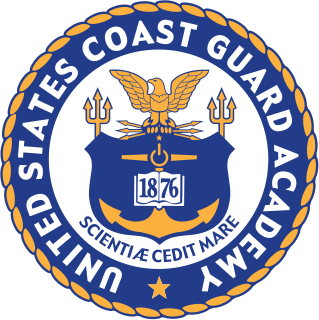 W
WThe United States Coast Guard Academy (USCGA) is the service academy of the United States Coast Guard in New London, Connecticut. Founded in 1876, it is the smallest of the five U.S. service academies and provides education to future Coast Guard officers in one of nine major fields of study. Unlike the other service academies, the Coast Guard Academy does not require a congressional nomination for admission.
 W
WThe Action of 1 March 1968 refers to a co-ordinated attempt by four North Vietnamese trawlers to resupply the Viet Cong and the efforts of Operation Market Time elements to stop them during the Vietnam War. On 28 February 1968, United States Navy SP-2H Neptune aircraft on routine patrol detected a North Vietnamese SL class naval trawler heading towards the South Vietnamese coast from north of the DMZ. By the next morning, three more trawlers were discovered and units of Operation Market Time were deployed for a surprise interception. The suspect trawlers did not fly flags so it was not until the start of the engagement that their origin was discovered. The trawlers were steel hulled vessels, 100 feet long and armed with 57-millimeter recoilless rifles and machine guns. All four vessels were loaded with weapons and ammunition intended to be delivered to the Viet Cong. American and South Vietnamese forces that engaged in action included the United States Coast Guard cutters Androscoggin, Point Grey, Point Welcome, Winona, Point Grace, Point Hudson, Point Marone, the swift boats USS PCF-18, USS PCF-20, USS PCF-42, USS PCF-43, USS PCF-46, USS PCF-47 and USS PCF-48, two South Vietnamese navy junks and one patrol boat. Two U.S. Army helicopter gunships also participated in combat as well as aircraft used to fire flares.
 W
WThe United States Coast Guard maintains roughly 145 Aids to Navigation Boats. These boats were designed primarily to serve within the inland waters of the United States. These vessels include TANB/BUSL/ATON/ANB ranging from 16 to 55 feet in length.
 W
WAmerica's Waterway Watch (AWW) is a program of the United States Coast Guard and its Reserve and Auxiliary components to encourage members of the public to be on the alert for suspicious behavior by boaters. As part of an effort to tighten security after the September 11 attacks of 2001, people involved in the maritime industry and recreational boating were encouraged by the Coast Guard to report suspicious activity to the National Response Center. In 2005, Coast Guard Commandant Thomas H. Collins issued Commandant Instruction 16618.8, formalizing the program as America's Waterway Watch.
 W
WAMVER, or Automated Mutual-Assistance Vessel Rescue System is a worldwide voluntary reporting system sponsored by the United States Coast Guard. It is a computer-based global ship-reporting system used worldwide by search and rescue authorities to arrange for assistance to persons in distress at sea. With AMVER, rescue coordinators can identify participating ships in the area of distress and divert the best-suited ship or ships to respond. Participating in AMVER does not put ships under any additional obligation to assist in search and rescue efforts, beyond that which is required under international law.
 W
WThe Bodie Island Lifesaving Station, also known as the Bodie Island Coast Guard Station, is located on the Outer Banks of North Carolina at the southern end of Bodie Island, within Cape Hatteras National Seashore. The 10-acre (4.0 ha) district includes a residence, the lifesaving station, the Coast Guard station, and an observation tower, as well as a number of utility buildings. The facility was turned over to the National Park Service in 1953, with the establishment of the national seashore. The primary structure, the lifesaving station, was built in 1878, and was converted to a residence when the Coast Guard station was built in 1925. It was moved to its present location in 1955, as it was threatened by shoreline erosion. The Coast Guard station was altered the same year to provide housing and office space for the National Park Service.
 W
WThe 2009 California mid-air collision occurred at sea, west of San Diego, on 29 October. It involved a Lockheed HC-130H Hercules of the United States Coast Guard and a Bell AH-1W Super Cobra of the United States Marine Corps. There were no survivors from the nine crew aboard either aircraft.
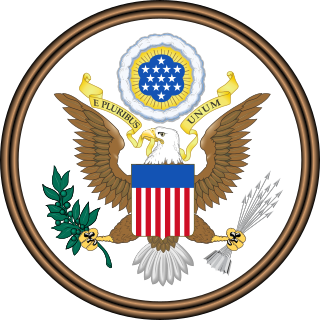 W
WThe Coast Guard Authorization Act of 2015 is an act of the United States that governs the activities of the United States Coast Guard (USCG) and the Federal Maritime Commission (FMC). The act also authorizes appropriations totaling about $17.5 billion, primarily for ongoing USCG operations over the 2016-2017 period.
 W
WA Coast Guard City is a United States municipality designated as such by the Commandant of the United States Coast Guard on application of the local civilian government. It is an honorary designation intended to recognize communities of special importance to the U.S. Coast Guard.
 W
WThe Coast Guard Museum Northwest is dedicated to preserving the heritage of the United States Coast Guard in the Pacific Northwest. The museum is located on the property of Coast Guard Station Seattle on the Elliott Bay waterfront south of Downtown, Seattle, Washington. It covers the full range of Coast Guard roles, ranging from protecting shores, lives and property to lighthouses and lightships, from life-saving stations to rescue boats, from buoy tenders to icebreakers and weather ships and from modern aircraft to patrol boats and cutters. The museum admittance is free of charge.
 W
WThe Coast Guard Mutual Assistance (CGMA) is an independent non-profit charitable organization of United States Coast Guard people assisting the Coast Guard family, including active duty, retired military, Coast Guard civilian employees, Coast Guard Reserve, Coast Guard Auxiliary, Public Health Service officers serving with the Coast Guard, and surviving family members. It receives no government funding, and has provided more than $200 million in financial assistance since 1924. There are more than 400 CGMA Representatives at 96 shore units and 38 cutters based in 32 states and territories, including Puerto Rico and Guam. CGMA receives no federal funds, and relies on bequests and donations from Coast Guard people. Most assistance is provided through interest-free loans and personal grants. These include educational support for members and their dependents, emergency travel, temporary living expenses, funeral expenses, loss of funds or property, disaster relief, medical and dental expenses, home studies expenses for adoptions, and debt management. The Supplemental Education Grant (SEG) program was enhanced in 2015. There is also a Layette Program to welcome infants. In 2017 CGMA provided 6 million dollars in direct assistance to its clients. Since 1924 CGMA has provided more than $187 million in assistance. CGMA has a four-star rating from Charity Navigator.
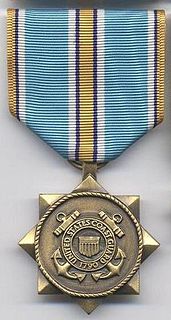 W
WThe United States Coast Guard maintains several civilian Public Service Awards to recognize private citizens, groups, or organizations for helping the Coast Guard carry out its missions. These awards are U.S. Government Awards issued by the Coast Guard, and like the Gold and Silver Lifesaving Medals, are not classified as military decorations, therefore, they may be awarded to any person.
 W
WCoast Guard Squadron One, also known in official message traffic as COGARDRON ONE or RONONE, was a combat unit formed by the United States Coast Guard in 1965 for service during the Vietnam War. Placed under the operational control of the United States Navy, it was assigned duties in Operation Market Time. Its formation marked the first time since World War II that Coast Guard personnel were used extensively in a combat environment.
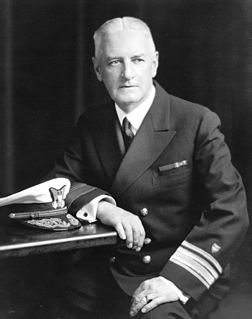 W
WThe Creed of the United States Coast Guardsman was written in 1938 by Vice Admiral Harry G. Hamlet, who served as Commandant of the Coast Guard from 1932 to 1936. According to former Commandant Robert Papp, the Creed described the duties and responsibilities that binds the group of Coast Guardsmen together as "shipmates".
 W
WThe Deployable Operations Group (DOG) was a United States Coast Guard command that provided properly equipped, trained and organized Deployable Specialized Forces (DSF), which still exist today, to the Coast Guard, DHS, DoD and inter-agency operational and tactical commanders. Formerly headquartered in Arlington, Virginia, it was established on 20 July 2007, and was commanded by a captain and was decommissioned by the Commandant of the Coast Guard, Admiral Robert Papp on 1 October 2013, although many of the units existed long before the 2007 commissioning. Upon decommissioning, the units previously assigned to the DOG were split between Coast Guard Pacific and Atlantic Area commands.
 W
WThe Douglas A. Munro Coast Guard Headquarters Building is the current headquarters of the United States Coast Guard and is located in Washington, D.C. on the west campus of the historic St. Elizabeths Hospital. The building is named in honor of Douglas Albert Munro and was completed in 2013.
 W
WThe Eagle Harbor Coast Guard Station Boathouse is a boathouse located at 9282 Marina Road in Eagle Harbor, Michigan. It was listed on the National Register of Historic Places in 2012.
 W
WEnsign Bafflestir is a cartoon strip created by the artist Ron Marlett during his enlistment in the United States Coast Guard. The cartoon ran from 1971 to 1974 in the US Coast Guard publication Pacific Shield, and featured a tongue-in-cheek look at daily life in the Coast Guard, as expressed through the exploits of a fictional ensign.
 W
WFleet Week is a United States Navy, United States Marine Corps, and United States Coast Guard tradition in which active military ships recently deployed in overseas operations dock in a variety of major cities for one week. Once the ships dock, the crews can enter the city and visit its tourist attractions. At certain hours, the public can take a guided tour of the ships. Often, Fleet Week is accompanied by military demonstrations and air shows such as those provided by the Blue Angels.
 W
WMyrtle Rae Holthaus Hazard, later Myrtle Gambrill, was an American electrician and radio operator in the United States Coast Guard during World War I. She was the first woman to enlist in the Coast Guard.
 W
WThe Heritage-class cutter, also known as the Offshore Patrol Cutter and the Maritime Security Cutter, Medium, is one design among several new cutter designs developed as part of the United States Coast Guard Integrated Deepwater System Program.
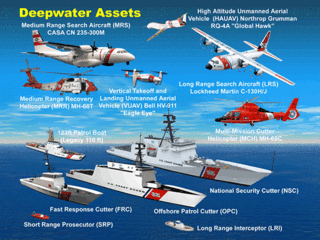 W
WThe Integrated Deepwater System Program was the 25-year program to replace all or much of the United States Coast Guard's equipment, including aircraft, ships, and logistics and command and control systems. The $24 billion program lost authorization in Fiscal Year 2012 and is officially defunct.
 W
WThe International Ice Patrol is an organization with the purpose of monitoring the presence of icebergs in the Atlantic and Arctic Oceans and reporting their movements for safety purposes. It is operated by United States Coast Guard but is funded by the 13 nations interested in trans-Atlantic navigation. As of 2011 the governments contributing to the International Ice Patrol include Belgium, Canada, Denmark, Finland, France, Germany, Greece, Italy, Japan, the Netherlands, Norway, Panama, Poland, Spain, Sweden, the United Kingdom, and the United States.
 W
WCoast Guard Base Kodiak is a major shore installation of the United States Coast Guard, located in Kodiak, Alaska. The largest tenant unit on the base is Air Station Kodiak. It is also the home port for several cutters. Historic elements that it includes are the Kodiak Naval Operating Base, Fort Greely, and Fort Abercrombie.
 W
WLaunch 5 is a restored NYPD patrol launch presently in use as a United States Coast Guard Auxiliary Facility as well as for volunteer non-profit environmental, public safety and educational work. Launch 5 enjoys a rich history beginning with her construction and dedication in 1966 and continuing to this day including valuable missions and enjoying substantial media exposure. Her crew is a group of volunteers who donate time and money to keep her afloat and to take her to public service.
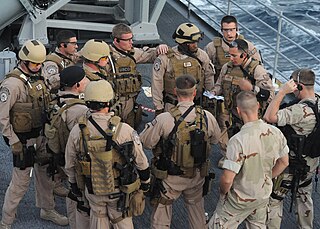 W
WLaw Enforcement Detachments or LEDETs are specialized, deployable maritime law enforcement teams of the United States Coast Guard. First established in 1982, their primary mission is to deploy aboard U.S. and allied naval vessels to conduct and support maritime law enforcement, interdiction, or security operations. LEDETs are the operational elements of the Coast Guard’s two Tactical Law Enforcement Teams (TACLETs) which were part of the Coast Guard’s Deployable Operations Group (DOG) from 2007 to 2013. As of April 2010 there are seventeen LEDETs.
 W
WIn the past most lesbian, gay, bisexual, transgender, and queer (LGBTQ) personnel had major restrictions placed on them in terms of service in the United States military. As of 2010 sexual orientation and gender identity in the United States military varies greatly as the United States Armed Forces have become increasingly openly diverse in the regards of LGBTQ people and acceptance towards them.
 W
WThe United States Coast Guard uses cutters and small boats on the water, and fixed- and rotary wing (helicopters) aircraft in the air. The Coast Guard employs various small arms including handguns, shotguns, rifles, and machine guns.
 W
WThis is a list of lighthouses in the United States. The United States has had approximately a thousand lights as well as light towers, range lights, and pier head lights. Michigan has the most lights of any state with over 150 past and present lights. Lighthouses that are in former U.S. territories are not listed here.
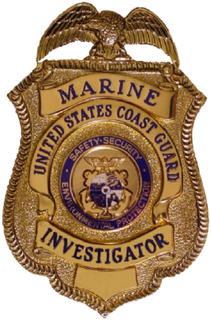 W
WUSCG Marine Investigators carry out all the statutorily mandated investigations of commercial vessel casualties and reports of violation that require a determination for apparent cause and culpability (fault). The findings of Coast Guard Marine Casualty Investigations are used to create safety recommendations to prevent future marine casualties. It is imperative that commercial vessel operators understand and follow the Marine Casualty reporting requirements as outlined in Title 46, Code of Federal Regulations, Part 4. Without timely and truthful reporting, the Coast Guard is hampered in its ability to conduct an accurate investigation. Therefore, responsible parties that fail to report Marine Casualties as required by regulations are subject to civil penalties.
 W
WMaritime Awareness Global Network (MAGNET) is an intelligence tool for the collection, correlation, fusion, and dissemination of maritime information via web-enabled user interfaces to specific user groups in support of maritime domain awareness (MDA).
 W
WA Maritime Force Protection Unit (MFPU) is a U.S. Coast Guard unit type tasked with the protection of U.S. Navy ballistic missile submarines (SSBN) while surfaced and transiting U.S. territorial waters to and from their patrol stations.
 W
WA Maritime Safety and Security Team, or MSST, is a counter-terrorism team of the United States Coast Guard established to protect local maritime assets. It is also a harbor and inshore patrol and security team that includes detecting and, if necessary, stopping or arresting submerged divers, using the Underwater Port Security System. It is the only special operations group that can arrest submerged divers.
 W
WMARSEC is the three-tiered United States Coast Guard Maritime Security system designed to easily communicate to the Coast Guard and the maritime industry pre-planned scalable responses for credible threats. Its objective is to provide an assessment of possible terrorist activity within the maritime sectors of transportation, including threats to nautical facilities and vessels falling within the jurisdiction of the United States that could be targets of attack.
 W
WMaritime and Science Technology Academy, commonly referred to as MAST Academy, or MAST, is a public high school in Miami, Florida, on Virginia Key. MAST Academy is a magnet school under the governance of Miami-Dade County Public Schools. The school's principal is Dr. Derick R. MacKoy, Sr., appointed in 2018. US News & World Report ranked MAST as the 42nd best high school in the nation as of 2015.
 W
WMinami-Tori-shima , also known as Marcus Island, is an isolated Japanese coral atoll in the northwestern Pacific Ocean, located some 1,848 kilometers (1,148 mi) southeast of Tokyo and 1,267 km (787 mi) east of the closest Japanese island, South Iwo Jima of the Ogasawara Islands, and nearly on a straight line between mainland Tokyo and Wake Island, 1,415 km (879 mi) further to the east-southeast. The closest island to Minami-Tori-shima is East Island in the Mariana Islands, which is 1,015 km (631 mi) to the west-southwest.
 W
WThe Marine Information for Safety and Law Enforcement (MISLE) is a database system managed and used by the United States Coast Guard (USCG). The MISLE is used to store data on marine accidental and deliberate pollution and other shipping and port accidents in US territorial waters. It accounts for vessels and other facilities, like port terminals and shipyards. The system has now been operational for a few years. It was introduced in December 2001 to replace the previous Marine Safety Information System (MSIS).
 W
WThe National Ice Center (NIC) is a tri-agency operational center whose mission is to provide worldwide navigational ice analyses for the armed forces of the United States, allied nations, and U.S. government agencies.
 W
WThe United States Navy Memorial is a memorial in Washington, D.C. honoring those who have served or are currently serving in the Navy, Marine Corps, Coast Guard, and the Merchant Marine.
Rescue 21 is an advanced maritime computing, command, control, and communications (C4) system designed to manage communications for the United States Coast Guard.
 W
WThe United States Coast Guard Reserve is the reserve component of the United States Coast Guard. It is organized, trained, administered, and supplied under the direction of the Commandant of the Coast Guard through the Assistant Commandant for Reserve (CG-R).
 W
WSea marshal is an internationally recognized term to describe armed law enforcement officers who board, sweep, search, protect, escort, and maintain control of vessels to prevent hijacking or acts of terrorism. In the United States of America, a sea marshal is a federal law enforcement officer who conducts fully armed boardings of maritime vessels for the purposes of ensuring the security and safety of the United States as well as the boarded ship, its cargo, and crew. Sea marshals/boarding officers operate under the jurisdiction of the United States Coast Guard within the US Department of Homeland Security.
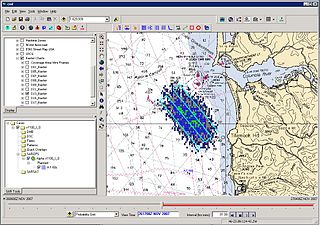 W
WSearch and Rescue Optimal Planning System (SAROPS) is a comprehensive search and rescue (SAR) planning system used by the United States Coast Guard in the planning and execution of almost all SAR cases in and around the United States and the Caribbean. SAROPS has three main components: The Graphical User Interface (GUI), the Environmental Data Server (EDS) and the Simulator (SIM). Using the Commercial Joint Mapping Tool Kit's (C/JMTK) government licensing of the Geographic Information System (GIS) SAROPS can be used in both a coastal and oceanic environment. Built into the simulator is the ability to access global and regional wind and current data sets making SAROPS the most comprehensive and powerful tool available for maritime SAR planners.
 W
W"Semper Paratus" is a 1928 song and the official march of the United States Coast Guard, having been composed in 1927 by U.S. Coast Guard Captain Francis Saltus Van Boskerck.
 W
WThe United States Coast Guard (USCG) Short Range Prosecutor is a 7-meter, high speed launch designed to be launched from cutters, at speed, from a stern launching ramp. The Short Range Prosecutor is a rigid-hull inflatable, powered by water-jets, for intercepting and boarding suspect vessels. It mounts a radar and special shock-proof seats, and can travel at 30 knots.
 W
WThe United States Coast Guard Academy's Swab Summer is a seven-week initiation through which all cadets are required to pass. It is the Academy's boot camp. Swab Summer is a unique nickname for the program at the Coast Guard comparable to Cadet Basic Training at the United States Military Academy and Plebe Summer at the United States Naval Academy.
 W
WKeith A. Taylor is an American retired United States Coast Guard Rear Admiral. He is the current Senior Vice President of Fleet Operations at Holland America Line Inc. and Seabourn Cruise Line Limited.
 W
WThe Transportation Worker Identification Credential program is a Transportation Security Administration and U.S. Coast Guard initiative in the United States. The TWIC program provides a tamper-resistant biometric credential to maritime workers requiring unescorted access to secure areas of port facilities, outer continental shelf facilities, and vessels regulated under the Maritime Transportation Security Act of 2002, or MTSA, and all U.S. Coast Guard credentialed merchant mariners. As of May 2014, there were 2,999,058 people enrolled in the program. Those seeking unescorted access to secure areas aboard affected vessels, and all Coast Guard credentialed merchant mariners, must obtain a TWIC. The new measures were fully implemented on April 15, 2009. To obtain a TWIC, an individual must provide biographic and biometric information such as fingerprints, sit for a digital photograph and successfully pass a security threat assessment conducted by TSA.
 W
WThe United States Coast Guard Auxiliary is the volunteer uniformed auxiliary service of the United States Coast Guard (USCG). Congress established the unit on June 23, 1939, as the United States Coast Guard Reserve. On February 19, 1941, the organization was re-designated as the United States Coast Guard Auxiliary. The Auxiliary exists to support all USCG missions on the water or in the air, except for roles that require "direct" law enforcement or military engagement. As of 2018, there were approximately 24,000 members of the U.S. Coast Guard Auxiliary.
 W
WThe Auxiliary University Programs (AUP) is a United States Coast Guard Auxiliary-managed initiative established in 2007. Today AUP now has nearly 200 members in 11 units representing over 30 colleges and universities across the United States. The Auxiliary University Program (AUP) prepares undergraduate and graduate students for future public service inside and outside of the Coast Guard. AUP provides the opportunity to attend college while learning to gain boating education, to learn about homeland security, and to gain operational and leadership experience. AUP has a positive track record of getting a large number of its graduates into Coast Guard Officer Candidate School. Members graduating AUP and choosing to enlist are automatically promotable to E-3 pay grade/rank when joining.
 W
WThe United States Coast Guard Police (CGPD) are law enforcement units stationed at certain shore facilities of the United States Coast Guard. Coast Guardsmen assigned to a CGPD receive either on-the-job training through their unit and may attend formal training through an approved police academy. CGPD officers may also attend advanced training for DUI, RADAR/LIDAR certification, active shooter situations, and other specialized skills that may be required. Officers wear a modified Operational Dress Uniform (ODU) with CGPD patches and collar devices in lieu of their rank. CGPD officers carry the same standard firearms as other Coast Guard units, including the Sig Sauer P229 DAK pistol, M-16, and shotguns. CGPDs utilize various patrol vehicles including bicycles, cars/SUVs, and ATVs. Officer responsibilities include physical security, answering calls for service, investigating minor crimes, traffic control, and the prevention, detection, and suppression of criminal activity aboard Coast Guard facilities. Coast Guard Police Departments are present at the United States Coast Guard Academy, Training Center Cape May, Training Center Petaluma, Base Support Unit Kodiak, USCG Sector New York, and the United States Coast Guard Yard, Baltimore.
 W
WThe United States Coast Guard Research & Development Center located in New London, Connecticut is the Coast Guard's center for operational analysis and mission execution solutions. The Research & Development Center is dedicated to maximizing its contribution by maintaining a balanced portfolio of projects that support the Coast Guard's short, medium, and long range requirements across all major missions. is the Coast Guard's sole facility performing research, development, test and evaluation (RDT&E) in support of the Coast Guard's major mission areas of; Environmental Protection, Maritime Law Enforcement, Protection of Life and Property at Sea and National Defense Preparedness. The R& D Center's technology research includes: detection, interdiction and prosecution of drug smugglers; cleaning up oil spills; maritime navigation safety; alertness and performance of commercial and CG crews; eliminating invasive species for ship ballast water. It is located in the Fort TRUMBULL section of New London at 1 Chelsea St. New London, 06320
 W
WThe U.S. Customshouse is a historic customs house and United States Coast Guard museum on Cobbs Hill at 3353 Main Street in Barnstable, Massachusetts. Built in 1855 to a design by Ammi Young, it was used as a custom house and post office until 1913, continuing to house the post office and other offices until 1958. It was converted into a museum in 1960, and was listed on the National Register of Historic Places in 1975.
 W
WThe United States Lighthouse Board was the second agency of the US Federal Government, under the Department of Treasury, responsible for the construction and maintenance of all lighthouses and navigation aids in the United States, between 1852 and 1910. The new agency was created following complaints of the shipping industry of the previous administration of lighthouses under the Treasury's Lighthouse Establishment, which had had jurisdiction since 1791, and since 1820, been under the control of Stephen Pleasonton. The quasi-military board first met on April 28, 1851, and with its establishment, the administration of lighthouses and other aids to navigation would take their largest leap toward modernization since the inception of federal government control. In 1910, the Lighthouse Board was disestablished in favor of a more civilian Lighthouse Service, under the Department of Commerce; later the Lighthouse Service was merged into the United States Coast Guard in 1939.
 W
WThe USCG Utility Boat, or UTB, was a standard utility boat used by the United States Coast Guard for a variety of inshore and offshore missions.